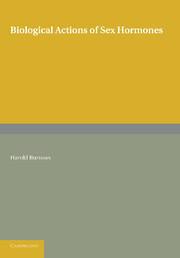CHAPTER XXIII - Sex Hormones of the Adrenal Cortex
from PART VI - SEX HORMONES OF THE ADRENAL CORTEX
Published online by Cambridge University Press: 05 June 2016
Summary
General considerations. Pituitary-adrenal relationship. Adrenal-gonad relationship. Adrenal virilism and feminism. Inactivation of deoxycorticosterone by the liver.
General Considerations
THE adrenal cortex has such an important share in the physiology of reproduction that it must be regarded as a sexual organ, though it has other than sexual functions to perform. As Kendall (1941) remarked, the adrenal cortex does not elaborate any single substance which can be described as the vital hormone of the gland. It produces numerous steroid compounds with different biological actions, and substitution therapy after adrenalectomy requires a combination of compounds.
Before considering those adrenal activities which bear directly on sexual life a few anatomical details may be recalled.
The adrenal cortex consists of three chief zones: the glomerular which is outermost, the fasciculate which is intermediate and the reticular which is inmost and immediately surrounds the medulla, which consists of nerve tissue. In young animals there is an additional zone lying next the medulla and described as the x zone (Elliott & Armour, 1911). This might perhaps be regarded not as a separate zone but as a reticular zone in its earlier form, when it differs greatly in appearance from that seen in the normal adult. Between the glomerular and fasciculate zones is a thin layer of smaller cells with condensed nuclei which has been described as the demarcation zone.
In the adult the adrenal cortex is replenished by mitoses of those glomerular cells which lie next the capsule (Zwemer, 1936; Grollman, 1936). As they pass inward from this region the cells become occupied by lipoid granules or droplets and eventually disintegrate, or disappear in some other manner, in the region of the reticular zone. In early life, and perhaps later, cell regeneration probably occurs also in or near the reticular zone. Changes in the adrenals accompany advancing age. The x zone soon disappears —during early infancy in man and about puberty in the mouse—though its disappearance may take place at different ages in the two sexes. With advanced age, especially in females, the zona fasciculata undergoes a characteristic change, the cells as they pass inward toward the medulla become increasingly laden with lipoid-like material, until as they approach the reticular region they may lose their cell walls and coalesce to form rounded masses of fat-like material containing pycnotic nuclei (Burrows, 1936b).
- Type
- Chapter
- Information
- Biological Actions of Sex Hormones , pp. 440 - 456Publisher: Cambridge University PressPrint publication year: 2013
- 1
- Cited by

